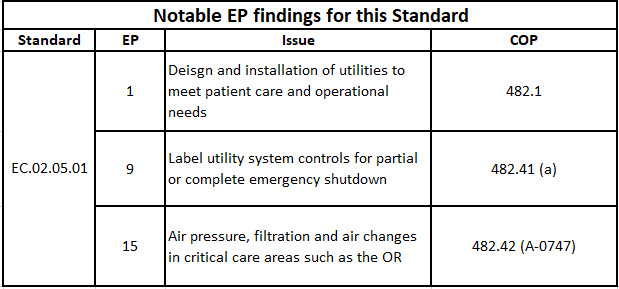Utility Systems - Clinical Impact
This content includes information linking Environment of Care and Life Safety Code deficiencies and their impact on patient care and patient safety.
EC.02.05.01: The hospital manages risks associated with its utility systems

According to the Centers for Disease Control (CDC), “There were an estimated 722,000 HAIs [Healthcare-Associated Infections] in U.S. acute care hospitals in 2011. About 75,000 hospital patients with HAIs died during their hospitalizations. More than half of all HAIs occurred outside of the intensive care unit.” [CDC Data & Statistics Web Page, 5/13/2015]
The CDC National Healthcare Safety Network (NHSN) Web Page, dated 5/13/2015 stated in the summary of the HAI Action Plan the following:
Healthcare-associated infections, or HAIs, are infections that people acquire while they are receiving treatment for another condition in a health care setting. HAIs can be acquired anywhere health care is delivered, including inpatient acute care hospitals… HAIs may be caused by any infectious agent, including bacteria, fungi, and viruses, as well as other less common types of pathogens. These infections are associated with a variety of risk factors, including:
-
Use of indwelling medical devices such as bloodstream, endotracheal, and urinary catheters
-
Surgical procedures
-
Injections
-
Contamination of the health care environment
-
Transmission of communicable diseases between patients and healthcare workers
-
Overuse or improper use of antibiotics
Contamination of the physical environment is fourth on the list in the CDC action plan
Research:
Air changes per hour (ACH) is a measure of how many times the air in a defined space is replaced. Studies have shown a relationship between ACH and infectious disease transmission. A 2007 study by Li and colleagues concluded “there is a strong and sufficient evidence to demonstrate an association between ventilation and air movements in buildings and the transmission and spread of infectious diseases such as measles, Mycobacterium (M.tb), chickenpox, influenza, smallpox and severe acute respiratory syndrome (SARS).”


